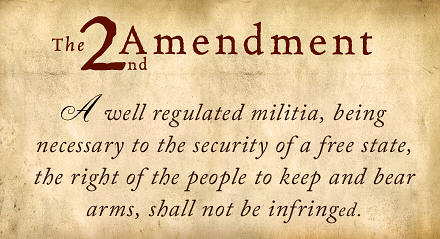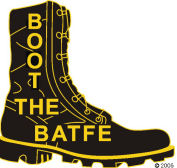

The Second Amendment: Obstacle or
Catalyst to Sensible Gun Legislation?
![]()

By James M. Maloney. April 2018
The Background
For almost my entire adult life before I reached the age of 50 (in 2008), I lamented that the United States Supreme Court had never given any substantive interpretation to the Second Amendment, which became a part of our Constitution in 1791. The Court would not even take a case to answer that most fundamental question: does the Second Amendment provide for an individual right or for a “collective” one? (The Amendment’s opening phrase, “[a] well-regulated militia,” seems to have allowed reasonable minds to differ for 217 years on that point.)
It was precisely because the Second Amendment had NOT been interpreted, I reasoned as a young adult, that sensible gun legislation was so difficult to enact in the United States. One side of the debate felt that the Second Amendment conveyed an inviolable right to individuals, while the other side believed that, at most, it allowed the states to arm their own national guards. There was no room for compromise, and, most importantly, no assurance to law-abiding “pro-gunners” that they would be protected against eventual total disarmament by the “anti-gunners.”
In June 2008, the Supreme Court decided District of Columbia v. Heller, and in a 5-to-4 majority opinion, written by the late Justice Antonin Scalia, held that the Second Amendment guarantees an individual right rather than a collective one. At last, I thought, we are on a path toward sensible legislation that can strike a reasonable balance between the exercise of the right to keep and bear arms and the recalcitrant plague of gun violence in America. But nearly ten years have gone by since then, and we seem no closer.
Part of the problem comes from the fact that the Supreme Court moves slowly, and that, as a result, there is still no well-developed jurisprudence of the Second Amendment. The Court has spoken only twice since Heller, once in 2010 in McDonald v. Chicago, which held that the Second Amendment is applicable as against state laws as well as federal ones, and again in 2016, in a case called Caetano v. Massachusetts. Caetano was a per curiam1 opinion that was issued without the case being briefed and heard first (a relatively unusual step for the Court to take). The Court simply reviewed the case record and issued a decision, in which it found that the Supreme Judicial Court of Massachusetts had made errors in its determination that a stun gun was not a protected “arm” for purposes of the Second Amendment. Specifically, the Supreme Court found that the Massachusetts high court had gotten it wrong on three counts when it said that stun guns were not a covered arm on the basis that: (1) stun guns “were not in common use at the time of the Second Amendment’s enactment”; (2) stun guns are “dangerous and unusual,” the latter because they are “a thoroughly modern invention”; and (3) there was “nothing in the record to suggest that [stun guns] are readily adaptable for use in the military.” For a particular weapon to give rise to Second Amendment protection, the Supreme Court explained in Caetano, it need not have been in existence at the time of the Second Amendment’s enactment, nor need it be related in any way to military use.
1 Latin for “by the court,” that is, with no named author.
Two observations about Caetano are worth making here. The first is that the decision created no new law–it simply applied principles that had been articulated in Heller, eight years earlier. The second observation, which is the more important for present purposes, is that there was no dissent in Caetano. Although Justice Samuel Alito wrote a concurrence joined by Justice Clarence Thomas, not a single Justice registered any direct disagreement with the substance of the Caetano per curiam opinion.
While it is far from clear where the Supreme Court will go in its next Second Amendment case, the lack of any dissent in Caetano makes it clear that the current Court is not about to reverse Heller and/or McDonald by declaring that the Second Amendment does not guarantee an individual right that is applicable as against both federal and state laws. Therefore, attempts to overturn those cases, or to enact legislation that is inconsistent with the basic principle that such a right exists, is not a wise allocation of resources. Far better to work on legislation that is consistent with those principles.
The Current Situation
In the wake of the Parkland High School shootings, a national movement is underway that may result in legislation that bans all semi-automatic firearms, or at least severely restricts or eliminates access to them by ordinary citizens. Two questions emerge: (1) Could such a law be passed on the national level (where it is needed if it is to be effective, since passing such laws at the state level is like trying to plug one hole in a leaking vessel while many others remain open)? and (2) Would such a law be held constitutional by the United States Supreme Court?
The passage of such a law at the national level would obviously require a majority in both Houses and, if vetoed, equivalent supermajorities. Leaving aside the role of the President, it is clear that to obtain a majority, especially in the Senate, the representatives of the lawful owners of firearms across America (whether or not they own semi-automatics) must be convinced that banning semi-automatics (or any class of weapons) would NOT be a first step toward banning ALL weapons. And, so far, Heller, McDonald, and Caetano are the closest thing we have to a solid assurance of that sort. In short, the Second Amendment is a catalyst for sensible legislation rather than an obstacle.
As to question (2), the seeds of a finding of constitutionality were sown in Heller, and perhaps watered and tended a bit in Caetano. In order for a weapon or class of weapons to be beyond Second Amendment protection (and therefore subject to a complete ban), it matters not whether the weapon was around in 1791, or whether it has military use. What does matter, then? Under Heller, it appears that a weapon may be banned altogether if it is “dangerous and unusual,” but Heller is far from clear as to the exact criteria for that. I would think (and indeed hope) that such criteria would relate primarily to the mass destructive capacity of the weapon, i.e., how easily it can be used for multiple homicides.
Unfortunately, the term “dangerous and unusual” is thrown about indiscriminately by state authorities in defense of just about any weapon ban, as Massachusetts did with regard to stun guns in Caetano, and as the Nassau County District Attorney is doing in my own federal case (which is now captioned Maloney v. Singas and which has been going for over 15 years now). In Maloney v. Singas, I have long been seeking nothing more than the right to possess a martial-arts weapon known as nunchaku or “nunchucks” in my own home.2 (New York banned any and all such possession back in 1974.) Of course, neither stun guns nor “nunchucks” have ever been used for (nor would they be very effective in committing) mass homicides at schools, movie theaters, airports, etc. But by indiscriminately seeking to label such devices as “dangerous and unusual” and thus subject to total bans with no Second Amendment protection at all, Massachusetts and Nassau County are actively feeding the fears of voters who worry about total disarmament but would, if secure against the threat of such a possibility, be inclined to support effective firearms-related legislation, even a total ban on semi-automatics. James M. Maloney, April 2018
2 Further details and updates about Maloney v. Singas are available at www.nunchakulaw.com.
James Maloney is admitted to practice law in the states of New York and New Jersey, and before numerous federal courts, including the United States Supreme Court, the United States Courts of Appeals for the Second and Third Circuits, the Court of International Trade, the Court of Federal Claims, and the United States District Courts for the Southern, Eastern and Northern Districts of New York, Northern District of Florida, Eastern District of Texas, Northern District of Illinois, District of Connecticut, and District of New Jersey.
![]()

























